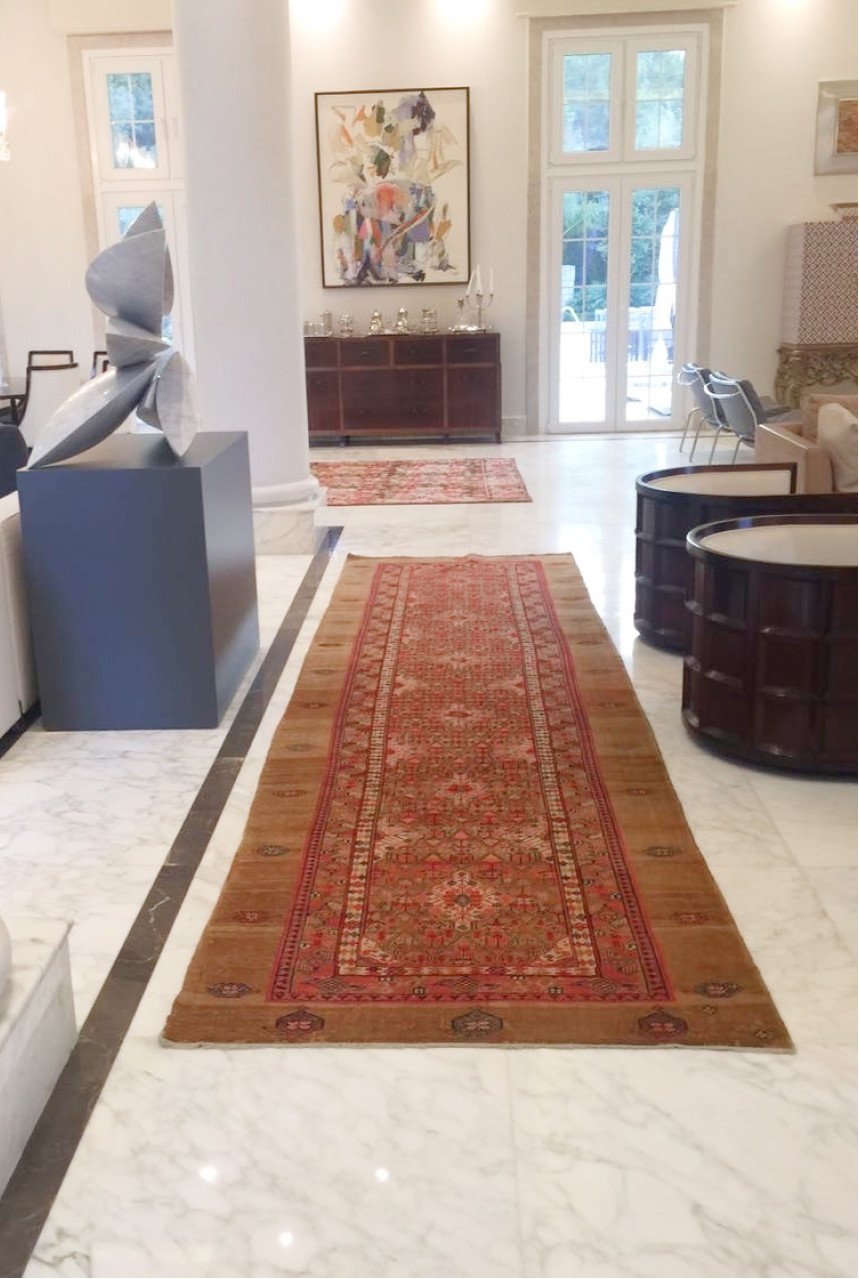At the other extreme of these self same societies we have the rich, ornate carpets commissioned by the leading artists of the day to decorate the palaces of Sultans, Emirs and Shahs. The most ubiquitous theme they shared, whether woven in Istanbul, Esfahan, Samarkand or Agra, was their quest to depict a heavenly garden—Paradise—on earth. This tradition of Garden Carpets goes back all the way to the Sassanid Dynasty that predates Islam. We see flowing water channels depicting the four rivers of water, wine, milk and honey described in the Quran. Lush vegetation abounds, with bounteous trees bearing fruits of all sorts. The magnificence of these masterpieces, today found in leading museums all around the world, left an imprint on the collective consciousness of carpet aficionados for centuries and they became an ideal to aspire to. The best way to praise a handmade carpet has become to claim that it is “fit for the Shah’s palace!” The fact that legendary rulers like Shah Abbas (1587 - 1629) was a carpet weaver himself only adds to the mystique, as does the knowledge that for long centuries carpets were the gift of choice between monarchs and rulers. Jahangir of India gifted Shah Abbas a pashmina carpet and the latter presented Murad III of Turkey a remarkably fine silk carpet in turn. These objects and events are well documented. When it comes to discussing the other 90% of carpets that survive, objects that belonged neither to kings nor to saints, we are faced with a cornucopia of mysterious motifs and secret symbols. They all had meanings when they were originally created or copied from the natural world or an artist’s imagination.
Many of them retain their clarity of depiction and their clear-cut symbolism while others’ meaning has been lost amidst the fogs of time. A majority of motifs on Oriental carpets are mere decorative ornament, generally in the case of flowers and most animals. Some however have particular meaning. Trees are all symbols of fertility and growth but the real Tree of Life is always a cypress. The weeping willow or bid majnun symbolizes sadness and nostalgia, a sense of waste and tragedy as in the romance of Layla & Majnun. Some motifs are straightforward in their symbolism: a crown for royalty or allegiance to the Shah, the comb on Caucasian prayer rugs standing for cleanliness, the peacock for fertility and prosperity in Persian village rugs, the ibriq ewer on Anatolian prayer rugs symbolizing ritual purity … A lion also stands for royalty and leadership in the ancient Persian tradition. Yet in the lion rug gabbehs of southern Iran they have an additional meaning. Tradition has it that when a girl’s hand in marriage is asked for among the nomadic Qashqai, she goes off to weave a lion rug while she considers the identity and character of her suitor. A few weeks later, the gabbeh is washed in the nearest river and hung to dry where members of the tribe may see it. If the lion’s tail is raised then that is a yes, whereas if it is lowered then the request has been denied—so endlessly endearing and captivatingly charming!

Purchasing carpets from Hadi Maktabi was the epitome of professionalism and joy. Hadi is an expert curator, purveyor, historian and story teller. His passion, knowledge, professionalism and expertise are evident every step of the way. With a wide range of choices and prices, prompt service, and fast sipping, we had our carpets in Sydney in a matter of days. The ultimate flying carpet experience! Zeina Tebbutt, Sidney, Australia 🇦🇺
As a carpet collector of 30 years, I have noticed a decline in the amount of truly unique and high quality carpets on the market. I have also noted a decline in the knowledge of merchants, generally. Hadi Maktabi stands against this trend as a both a curator for and an educator of his clients. His offerings are well-researched, museum quality carpets that are both singular and expertly chosen. In dealing with Hadi, I have experienced excellent communication, a high standard of service and extremely pleasant interactions. Warren D., Hong Kong 🇭🇰
You can't only be a customer of Hadi Maktabi. While his main purpose is rug dealing, he starts with story telling and ends with history selling. That's what I call high-end art curating and closing it all with an entertaining friendship. George El Hani, CEO Levica, Lebanon 🇱🇧